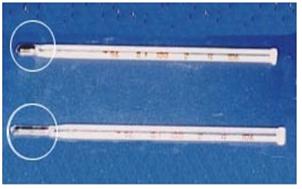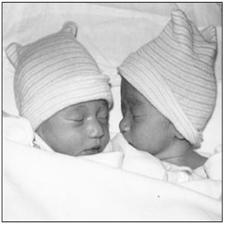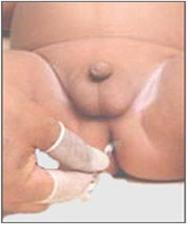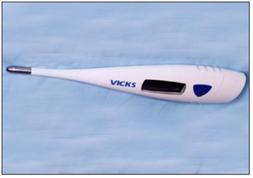신생아의 체온, Body temperature of newborn infants
- 신생아들의 체온조절은 신생아기 이후 영유아들이나 학령기 아이들이 체온 조절을 하는 것에 비해 미숙하게 한다.
- 즉, 신생아기 이후 소아들-영아들, 유아들, 또는 학령기 아이들이 체온을 조절하는 생리 기능과 다른 점이 많다.
- 신생아의 피부층의 총면적은 신생아의 체중에 비해 더 넓고, 신생아의 피하 지방층 두께가 더 얇고, 신생아의 체온 조절 중추 신경의 기능이 더 미숙해 신생아들은 그들 스스로 체온을 잘 조절할 수 없다.
표 2-4.나이(일령)에 따른 미숙 신생아와 만삭 신생아의 정상체온
| 출생체중 | 체중 1,500gm
(3 lb, 5 oz) 이하 |
체중 1,501 gm~ 2,500 gm
(3 lb, 5 oz ~ 5 lb, 8 oz) |
임신 36주 이상
2,500 gm (3 lb, 8 oz) 이상 |
|||||||||
| 화씨 또는 섭씨
나이 |
체온 섭씨
평균치±범위 |
체온 화씨
평균치±범위 |
체온 섭씨
평균치±범위 |
체온 화씨
평균치±범위 |
체온 섭씨
평균치±범위 |
체온 화씨
평균치±범위 |
||||||
| 생후 1일 | 34.3 | 0.4 | 93.8 | 0.7 | 33.4 | 0.6 | 92.1 | 1.1 | 33.0 | 1.0 | 91.4 | 1.8 |
| 생후 2일 | 33.7 | 0.5 | 92.7 | 0.9 | 32.7 | 0.9 | 90.9 | 1.6 | 32.4 | 1.3 | 90.4 | 2.3 |
| 생후 3일 | 33.5 | 0.5 | 92.3 | 0.9 | 32.4 | 0.9 | 90.4 | 1.6 | 31.9 | 1.3 | 89.4 | 2.3 |
| 생후 4일 | 33.5 | 0.5 | 92.3 | 0.9 | 32.3 | 0.9 | 90.2 | 1.6 | 31.5 | 1.3 | 89.6 | 2.3 |
| 생후 5일 | 33.5 | 0.5 | 92.3 | 0.9 | 32.2 | 0.9 | 90.0 | 1.6 | 31.2 | 1.3 | 88.1 | 2.3 |
| 생후 6일 | 33.5 | 0.5 | 92.3 | 0.9 | 32.1 | 0.9 | 89.8 | 1.6 | 30.9 | 1.3 | 87.6 | 2.3 |
| 생후 7일 | 33.5 | 0.5 | 92.3 | 0.9 | 32.1 | 0.9 | 89.8 | 1.6 | 30.8 | 1.4 | 87.4 | 2.5 |
| 생후 8일 | 33.5 | 0.5 | 92.3 | 0.9 | 32.1 | 0.9 | 89.8 | 1.6 | 30.6 | 1.4 | 87.5 | 2.5 |
| 생후 9일 | 33.5 | 0.5 | 92.3 | 0.9 | 32.1 | 0.9 | 89.8 | 1.6 | 30.4 | 1.4 | 86.7 | 2.5 |
| 생후 10일 | 33.5 | 0.5 | 92.3 | 0.9 | 32.1 | 0.9 | 89.8 | 1.6 | 30.2 | 1.5 | 86.4 | 2.7 |
| 생후 11일 | 33.5 | 0.5 | 92.3 | 0.9 | 32.1 | 0.9 | 89.8 | 1.6 | 29.9 | 1.5 | 85.8 | 2.7 |
| 생후 12일 | 33.5 | 0.5 | 92.3 | 0.9 | 32.1 | 0.9 | 89.8 | 1.6 | 29.5 | 1.6 | 85.1 | 2.8 |
| 생후 13일 | 33.5 | 0.5 | 92.3 | 0.9 | 32.1 | 0.9 | 89.8 | 1.6 | 29.2 | 1.6 | 84.6 | 2.8 |
| 생후 14일 | 33.4 | 0.6 | 92.1 | 1.1 | 32.1 | 0.9 | 89.8 | 1.6 | – | – | – | – |
| 생후 15일 | 33.3 | 0.7 | 92.0 | 1.3 | 32.0 | 0.9 | 89.6 | 1.6 | – | – | – | – |
| 생후 4주 | 32.9 | 0.8 | 91.2 | 1.4 | 31.7 | 1.1 | 89.0 | 1.9 | – | – | – | – |
| 생후 5주 | 32.1 | 0.7 | 89.8 | 1.3 | 31.1 | 1.1 | 87.9 | 1.9 | – | – | – | – |
| 생후 6주 | 31.8 | 0.6 | 89.2 | 1.1 | 30.6 | 1.1 | 87.1 | 1.9 | – | – | – | – |
| 생후 7주 | 31.1 | 0.6 | 87.9 | 1.1 | 30.1 | 1.1 | 86.2 | 1.9 | – | – | – | – |
출처 Standards and recommendations for Hospital Care of Newborn Infants, American Academy of Pediatrics. 5th, ed. p.91

사진 2-104. 유리 체온계
수은 체온계가 깨질 때 그 속에 있는 수은으로 수은 중독에 걸릴 수 있다. 유리 체온계로 체온을 측정하는 것을 권장하지 않는다. 그러나 실용적이다.
상-항문 체온계, 하-구강 체온계
Copyright ⓒ 2011 John Sangwon Lee, MD., FAAP
- 이런저런 정상 생리적 조건에 따라, 신생아들은 체내 열량을 짧은 시간 내 더 쉽게 더 많이 잃을 수 있다.
- 또 신생아들은 그들의 주위에서 열을 쉽게 받을 수 있다.
- 그로 인해 신생아의 체온이 쉽게 상승되기도 하고 열이 날 수 있다.
- 가령, 주위 온도가 하강할 때 체온이 쉽게 떨어질 수 있고 그로 인해 저체온이 신생아에게 생길 수 있다.
- 갓 태어난 아기의 전신에 묻은 양수가 마르면서 몸에서 많은 열량을 잃는다.
- 그래서 체온이 많이 떨어질 수 있다.
- 특히 주위 온도가 낮을 때 체온이 떨어지지 않도록 신생아기 이후 영유아들이나 그 이후 학령기 아이들, 사춘기 아이들, 성인들은 땀샘 구멍들을 꼭 막아 체내 열이 체외로 발산되지 않게 한다.
- 신생아들은 생리적으로 미숙해서 주위 온도가 변화함에 따라 땀샘 구멍들을 꼭 막고 여는 기능도 원활하지 않다.
- 예를 들면, 주위의 온도가 올라갈 때 신생아기 이후 소아들이나 성인들의 땀구멍들이 자율신시경의 영향으로 열리고 땀이 나게 하고 체온이 낮아지는 생리적 기능이 원활해진다.
- 그러나 신생아들에게는 그런 생리적 기능이 미숙하다.
- 그 들의 주위 온도가 상승되거나, 하강됨에 따라 신생아들의 체온은 쉽게 덩달아 올라갈 수 있고 내려갈 수 있다.
- 이런 현상은 영아들에게도 생길 수 있고 허약한 아이들이나 노쇠한 노인들에게도 더 잘 생길 수 있다.
- 실내 온도가 낮거나 옷을 적절히 입히지 않거나 잘 덮어 주지 않던지, 또는 찬 인공영양을 먹을 때 신생아들의 체온은 쉽게 떨어질 수 있다. 그 때문에 몸이 쉽게 차질 수 있고, 때로는 손발이 파래져서 선단 청색증이 생길 수 있다.
- 그와 정반대로 너무 덥게 옷을 입히거나 담요 등으로 너무 많이 싸줄 때, 또는 실내 온도가 너무 높을 때 체온이 쉽게 올라가서 신생아에게 열이 날 수 있다. 때로는 고열도 나고 땀도 나고 호흡수도 증가되고 탈수 열도 날 수 있다.

사진 2-105.병원 산실에서 미숙아로 태어난 쌍둥아들.
신생아의 두부의 피부 면적은, 특히 미숙아들의 경우 전신의 총 피부 면적의 상당 부분을 차지한다. 신체에서 열이 방출되는 것을 방지하기 위해 몸을 적절히 잘 싸주고 머리에 모자를 씌워 체열이 상살 되지 않게 예방한다.
Copyright ⓒ 2011 John Sangwon Lee, MD., FAAP

사진 2-106. 신생아의 체온은 겨드랑이나 항문에서 잴 수 있다. 그 중 항문에서 잰 체온이 더 정확하다.
Copyright ⓒ 2011 John Sangwon Lee, MD., FAAP
출처 및 참조 문헌
- [부모도 반의사가 되어야 한다- 소아가정간호 백과]-제 1권 소아청소년 응급의료-고열이 날 때, 열성 경련,
- 신생아 탈수 열,
- 신생아가 열이 날 때,
- 미숙신생아 체온 조절,
- 신생아가 열이 나면 어떻게 하나요,
- 열이 날 때 참조.
| 신생아의 정상 체온 |
- 신생아들의 정상 체온은 36.5∼37.5℃이다.
- 신생아의 체온을 정상으로 유지하기 위해 다음과 같은 처치가 필요하다.
- 방안의 온도를 27∼31℃ 정도로 유지한다.
- 방안의 습도를 30∼60%로 유지한다.
- 출생 후 가능하면 신생아의 피부에 묻은 양수, 태지, 피 등을 부드럽고 깨끗한 물수건으로 잘 닦아 준 후 따뜻한 담요 등으로 적절히 싸준다.
- 갓 태어난 신생아를 담요 등으로 너무 덥게 싸주거나 방안의 온도가 너무 높으면 신생아 체온이 39∼40℃까지 올라갈 수 있다.
- 주위 온도가 너무 높아 신생아의 체온이 정상 이상으로 올라가면 숨을 가쁘게 쉬고 호흡이 빨라져 신생아에게 빈호흡증이 생길 수 있다.
- 분만 전이나 분만 중 어떤 감염병을 앓는 엄마로부터 태어난 신생아에게 고열이 날 수 있다.
- 실내 온도, 신생아가 입은 옷, 신생아를 얼마나 많이 싸주느냐에 따라 신생아 체온이 변할 수 있다.
- 아침 낮 저녁 기온의 변화에 따라, 실내 온도, 옷, 덮는 이불 등을 적절히 조절해서 신생아 체온을 적절히 조절한다.
- 태어난 이후 신생아 체온을 잘 조절해 신생아가 춥거나 덥지 않게 하는데 부모의 깊는 사려가 많이 요한다.

사진 2-107. 요즘 전자 체온계로 소아들의 체온을 잰다. Copyright ⓒ 2011 John Sangwon Lee, MD., FAAP
Body temperature of newborn infants 신생아의 체온
- The temperature control of newborns is immature compared to that of infants and school-age children after the neonatal period.
- In other words, there are many differences from the physiological function of regulating body temperature in children-infants, infants, or school-age children after the neonatal period.
- The total area of the newborn’s skin layer is wider than that of the infants, the thickness of the subcutaneous fat layer of the newborn is thinner, and the newborn’s body temperature-regulating central nerve function is more immature, so the newborns cannot control their own body temperature well.
Table 2-4. Normal body temperature of immature and term newborns according to age (age)
표 2-4.나이(일령)에 따른 미숙 신생아와 만삭 신생아의 정상체온
| Birth weight | Weight 1,500gm
(3 lb, 5 oz) and or less |
Weight 1,501 gm~ 2,500 gm
(3 lb, 5 oz ~ 5 lb, 8 oz) |
임신 36주 이상
2,500 gm (3 lb, 8 oz) or more |
|||||||||
| Fahrenheit or Celsius /age | Body temperature Celsius, Mean ± range | Body temperature Fahrenheit, Mean ± range | Body temperature Celsius, Mean ± range | Body temperature Fahrenheit, Mean ± range | Body temperature Celsius, Mean ± range | Body temperature Fahrenheit, Mean ± range | ||||||
| 1 day | 34.3 | 0.4 | 93.8 | 0.7 | 33.4 | 0.6 | 92.1 | 1.1 | 33.0 | 1.0 | 91.4 | 1.8 |
| 2 day | 33.7 | 0.5 | 92.7 | 0.9 | 32.7 | 0.9 | 90.9 | 1.6 | 32.4 | 1.3 | 90.4 | 2.3 |
| 3 day | 33.5 | 0.5 | 92.3 | 0.9 | 32.4 | 0.9 | 90.4 | 1.6 | 31.9 | 1.3 | 89.4 | 2.3 |
| 4 day | 33.5 | 0.5 | 92.3 | 0.9 | 32.3 | 0.9 | 90.2 | 1.6 | 31.5 | 1.3 | 89.6 | 2.3 |
| 5 day | 33.5 | 0.5 | 92.3 | 0.9 | 32.2 | 0.9 | 90.0 | 1.6 | 31.2 | 1.3 | 88.1 | 2.3 |
| 6 day | 33.5 | 0.5 | 92.3 | 0.9 | 32.1 | 0.9 | 89.8 | 1.6 | 30.9 | 1.3 | 87.6 | 2.3 |
| 7 day | 33.5 | 0.5 | 92.3 | 0.9 | 32.1 | 0.9 | 89.8 | 1.6 | 30.8 | 1.4 | 87.4 | 2.5 |
| 8 day | 33.5 | 0.5 | 92.3 | 0.9 | 32.1 | 0.9 | 89.8 | 1.6 | 30.6 | 1.4 | 87.5 | 2.5 |
| 9 day | 33.5 | 0.5 | 92.3 | 0.9 | 32.1 | 0.9 | 89.8 | 1.6 | 30.4 | 1.4 | 86.7 | 2.5 |
| 10 day | 33.5 | 0.5 | 92.3 | 0.9 | 32.1 | 0.9 | 89.8 | 1.6 | 30.2 | 1.5 | 86.4 | 2.7 |
| 11 day | 33.5 | 0.5 | 92.3 | 0.9 | 32.1 | 0.9 | 89.8 | 1.6 | 29.9 | 1.5 | 85.8 | 2.7 |
| 12 day | 33.5 | 0.5 | 92.3 | 0.9 | 32.1 | 0.9 | 89.8 | 1.6 | 29.5 | 1.6 | 85.1 | 2.8 |
| 13 day | 33.5 | 0.5 | 92.3 | 0.9 | 32.1 | 0.9 | 89.8 | 1.6 | 29.2 | 1.6 | 84.6 | 2.8 |
| 14 day | 33.4 | 0.6 | 92.1 | 1.1 | 32.1 | 0.9 | 89.8 | 1.6 | – | – | – | – |
| 15 day | 33.3 | 0.7 | 92.0 | 1.3 | 32.0 | 0.9 | 89.6 | 1.6 | – | – | – | – |
| 4 week | 32.9 | 0.8 | 91.2 | 1.4 | 31.7 | 1.1 | 89.0 | 1.9 | – | – | – | – |
| 5 week | 32.1 | 0.7 | 89.8 | 1.3 | 31.1 | 1.1 | 87.9 | 1.9 | – | – | – | – |
| 6 week | 31.8 | 0.6 | 89.2 | 1.1 | 30.6 | 1.1 | 87.1 | 1.9 | – | – | – | – |
| 7 week | 31.1 | 0.6 | 87.9 | 1.1 | 30.1 | 1.1 | 86.2 | 1.9 | – | – | – | – |
Source: Standards and recommendations for Hospital Care of Newborn Infants, American Academy of Pediatrics. 5th, ed. p.91

Photo 2-104. Glass thermometer.
When a mercury thermometer breaks, the mercury in it can lead to mercury poisoning. It is not recommended to measure a newborn’s body temperature with a glass thermometer. But it is practical. Upper-anal thermometer, lower-oral thermometer Copyright ⓒ 2011 John Sangwon Lee, MD., FAAP
- Under normal physiological conditions of one or the other, newborns can more easily lose more calories in their bodies in a short amount of time.
- In addition, newborns can easily get heat around them. As a result, the newborn’s body temperature may rise easily and may cause fever.
- For example, when the ambient temperature drops, the body temperature can easily drop, which can lead to hypothermia in newborns.
- As the amniotic fluid on the body of a newborn baby dries, the body loses a lot of calories.
- So, your baby’s body temperature can drop a lot. In particular, in order to prevent body temperature from dropping when the ambient temperature is low, infants and toddlers after the neonatal period, school-age children, adolescents, and adults after the neonatal period must close the sweat glands holes to prevent body heat from radiating out of the body.
- Newborns are physiologically immature, and as the ambient temperature changes, the function of tightly closing and opening sweat glands is not smooth.
- For example, when the surrounding temperature rises, the physiological function of children’s and adults’ pores opening and sweating under the influence of the autonomic nephroscope and lowering body temperature after the neonatal period becomes smooth.
- However, such physiological functions are immature in newborns. As their ambient temperature rises or falls, the body temperature of newborns can easily rise and fall. This phenomenon can occur in infants as well, and is more likely to occur in frail children or senile seniors.
- Newborns’ body temperature can easily drop when the room temperature is cold, when the clothes are not properly dressed or covered well, or when they eat cold artificial nutrients. Because of this, the body can be easily settled, and sometimes the hands and feet become blue, leading to apical cyanosis.
- Conversely, when you dress too hot, wrap too much with a blanket, etc., or when the room temperature is too high, the body temperature can easily rise and the newborn can get a fever.
- Sometimes high fever, sweating, increased respiratory rate, and dehydration fever can occur.

Picture 2-105.
Twin boys born as premature babies in the hospital’s birthroom. The skin area of the head of a newborn, especially in the case of premature babies, accounts for a significant portion of the total skin area of the whole body.
To prevent heat from being released from the body, wrap the body properly and put a hat on the head to prevent the body heat from being hurt. Copyright ⓒ 2011 John Sangwon Lee, MD., FAAP

Photo 2-106. A newborn’s body temperature can be measured in the armpit or anus. Among them, the body temperature measured in the anus is more accurate. Copyright ⓒ 2011 John Sangwon Lee, MD., FAAP
- Sources and references [Parents should also be at least the half-doctors-Encyclopedia of Child and Family Nursing]-Vol. 1 Emergency medical care for children and adolescents-High fever, febrile convulsions, Newborn dehydration fever, When a newborn has a fever, Body temperature control of premature newborns, What to do if your newborn has a fever, See when you have a fever.
Normal body temperature in newborns
- The normal body temperature of newborns is 36.5~37.5℃. In order to keep the newborn’s body temperature normal, the following treatments are required. Keep the room temperature around 27~31℃. Keep the humidity in the room at 30-60%. After birth, if possible, wipe off the amniotic fluid, skin, and blood on the newborn’s skin with a soft, clean wet towel and wrap it properly with a warm blanket.
- If a newborn baby is wrapped too hot with a blanket or the room temperature is too high, the newborn’s body temperature can rise to 39-40℃.
- If the ambient temperature is too high and the newborn’s body temperature rises above normal, it can cause short breathing and rapid breathing, which can lead to tachypnea in the newborn.
- High fever can occur in newborns born to mothers who have some infectious disease before or during delivery.
- The temperature of the newborn baby can change depending on the room temperature, the clothes the newborn wears, and how much wraps the newborn baby.
- According to the change of temperature in the morning, day and night, the temperature of the newborn baby is properly controlled by appropriately adjusting the room temperature, clothes, and blankets.
- After birth, the newborn’s body temperature is well controlled so that the newborn does not get cold or hot, but it requires a lot of thoughtful consideration from parents.

Photo 2-107. These days, electronic thermometers measure the temperature of children. Copyright ⓒ 2011 John Sangwon Lee, MD., FAAP
출처 및 참조 문헌
- NelsonTextbook of Pediatrics 22ND Ed
- The Harriet Lane Handbook 22ND Ed
- Growth and development of the children
- Red Book 32nd Ed 2021-2024
- Neonatal Resuscitation, American Academy Pediatrics
- www.drleepediatrics.com 제1권 소아청소년 응급 의료
- www.drleepediatrics.com 제2권 소아청소년 예방
- www.drleepediatrics.com 제3권 소아청소년 성장 발육 육아
- www.drleepediatrics.com 제4권 모유,모유수유, 이유
- www.drleepediatrics.com 제5권 인공영양, 우유, 이유식, 비타민, 미네랄, 단백질, 탄수화물, 지방
- www.drleepediatrics.com 제6권 신생아 성장 발육 육아 질병
- www.drleepediatrics.com제7권 소아청소년 감염병
- www.drleepediatrics.com제8권 소아청소년 호흡기 질환
- www.drleepediatrics.com제9권 소아청소년 소화기 질환
- www.drleepediatrics.com제10권. 소아청소년 신장 비뇨 생식기 질환
- www.drleepediatrics.com제11권. 소아청소년 심장 혈관계 질환
- www.drleepediatrics.com제12권. 소아청소년 신경 정신 질환, 행동 수면 문제
- www.drleepediatrics.com제13권. 소아청소년 혈액, 림프, 종양 질환
- www.drleepediatrics.com제14권. 소아청소년 내분비, 유전, 염색체, 대사, 희귀병
- www.drleepediatrics.com제15권. 소아청소년 알레르기, 자가 면역질환
- www.drleepediatrics.com제16권. 소아청소년 정형외과 질환
- www.drleepediatrics.com제17권. 소아청소년 피부 질환
- www.drleepediatrics.com제18권. 소아청소년 이비인후(귀 코 인두 후두) 질환
- www.drleepediatrics.com제19권. 소아청소년 안과 (눈)질환
- www.drleepediatrics.com 제20권 소아청소년 이 (치아)질환
- www.drleepediatrics.com 제21권 소아청소년 가정 학교 간호
- www.drleepediatrics.com 제22권 아들 딸 이렇게 사랑해 키우세요
- www.drleepediatrics.com 제23권 사춘기 아이들의 성장 발육 질병
- www.drleepediatrics.com 제24권 소아청소년 성교육
- www.drleepediatrics.com 제25권 임신, 분만, 출산, 신생아 돌보기
- Red book 29th-31st edition 2021
- Nelson Text Book of Pediatrics 19th- 21st Edition
- The Johns Hopkins Hospital, The Harriet Lane Handbook, 22nd edition
- 응급환자관리 정담미디어
- Pediatric Nutritional Handbook American Academy of Pediatrics
- 소아가정간호백과–부모도 반의사가 되어야 한다, 이상원 저
- The pregnancy Bible. By Joan stone, MD. Keith Eddleman, MD
- Neonatology Jeffrey J. Pomerance, C. Joan Richardson
- Preparation for Birth. Beverly Savage and Dianna Smith
- 임신에서 신생아 돌보기까지. 이상원
- Breastfeeding. by Ruth Lawrence and Robert Lawrence
- Sources and references on Growth, Development, Cares, and Diseases of Newborn Infants
- Emergency Medical Service for Children, By Ross Lab. May 1989. p.10
- Emergency care, Harvey Grant and Robert Murray
- Emergency Care Transportation of Sick and Injured American Academy of Orthopaedic Surgeons
- Emergency Pediatrics A Guide to Ambulatory Care, Roger M. Barkin, Peter Rosen
- Quick Reference To Pediatric Emergencies, Delmer J. Pascoe, M.D., Moses Grossman, M.D. with 26 contributors
- Neonatal resuscitation Ameican academy of pediatrics
- Pediatric Nutritional Handbook American Academy of Pediatrics
- Pediatric Resuscitation Pediatric Clinics of North America, Stephen M. Schexnayder, M.D.
-
Pediatric Critical Care, Pediatric Clinics of North America, James P. Orlowski, M.D.
-
Preparation for Birth. Beverly Savage and Dianna Smith
-
Infectious disease of children, Saul Krugman, Samuel L Katz, Ann A.
- 제4권 모유, 모유수유, 이유 참조문헌 및 출처
- 제5권 인공영양, 우유, 이유, 비타민, 단백질, 지방 탄수 화물 참조문헌 및 출처
- 제6권 신생아 성장발육 양호 질병 참조문헌 및 출처
- 소아과학 대한교과서
|
Copyright ⓒ 2015 John Sangwon Lee, MD., FAAP 미국 소아과 전문의, 한국 소아청소년과 전문의 이상원 저 “부모도 반의사가 되어야 한다”-내용은 여러분들의 의사로부터 얻은 정보와 진료를 대신할 수 없습니다. “The information contained in this publication should not be used as a substitute for the medical care and advice of your doctor. There may be variations in treatment that your doctor may recommend based on individual facts and circumstances. “Parental education is the best medicine.” |